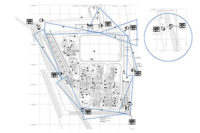Bringing Power and Communications to an Outdoor Security System

Dealers have devised some clever disguises for outdoor cameras — including hiding one inside a cactus.
Photo Courtesy of Videofied

Wireless devices — such as this photoelectric break-beam detector — can eliminate the need to run wiring.
Photo courtesy of Dakota Alert

Thermal imaging cameras may be a good option for protecting areas that lack power for lighting.
Photo Courtesy of FLIR Systems



When a customer needs perimeter or outdoor protection, the most challenging aspects of the job often are power and communication. Video, motion sensors, break beams, access control readers and other security devices all need to be able to send alerts and other information; and all of them need some form of electrical power.
Dealers will be able to best meet those needs if they know all of their options — and which are best for various situations.
Battery Power
Often outdoor installations lack both power and communications. In that case, one of the most economical solutions will be to use battery power and wireless communications.
Whether batteries are an option depends on the . devices being installed and how frequently it will be practical for someone to change the batteries. Passive infrared detectors, for example, generally have minimal power requirements. Jason Quam, sales manager and vice president of ElkPoint, S.D.-based manufacturer Dakota Alert, says that Dakota has a wireless PIR that runs for a year on a single 9-volt battery. He notes, though, that the company’s break-beam detector draws more power because it’s an active device; therefore dealers often use solar technology to power it (See “Solar Power Tips From an Expert” on page 83).
Some of the receivers to which battery-operated devices communicate are designed to plug into a traditional electrical socket. But at least one company — Minneapolis-based equipment manufacturer Videofied — offers a receiver that runs for up to four years on D cell batteries, along with other battery-powered devices and cameras. The receiver also communicates via cellular to a central station, enabling it to be installed in remote areas. Videofied President Keith Jentoft notes, for example, that some ranchers are using the equipment to prevent cattle rustling — a criminal activity that has come back into vogue as the result of climbing meat prices.
Another challenge involving power for video systems is lighting. But as Ted Brahms, director of field operations for Glendale, Calif.-based manufacturer Arecont Vision LLC., notes, some cameras have built-in LED-based infrared illuminators that use solid state electronics, helping to minimize power requirements. The range of those illuminators tends to be somewhat limited but if an installation requires a larger coverage area, some third-party illuminators also have relatively low power requirements, he says.
Thermal cameras also may be a relatively low-power alternative to traditional video and lighting options. “We often see our thermal imagers deployed with solar power,” comments Matt Bretoi, vice president of field sales for Wilsonville, Ore.-based manufacturer FLIR Systems.
Wireless
Dealers have a wide range of options to choose from when it comes to wireless communications for perimeter protection.
One option is to use Wi-Fi — a technology optimized for high-bandwidth transmission, making it well suited for video, which among security applications tends to consume the greatest bandwidth. The downside of Wi-Fi for outdoor installations, though, is that it provides relatively limited range.
As an alternative, security manufacturers offer equipment that operates in the 2.4 GHz band but doesn’t use Wi-Fi, as well as alternatives that operate in the lower frequency 433 MHz and 900 MHz bands.
As Jentoft explains, lower frequency equipment tends to have greater range but provides lower bandwidth than higher frequency equipment. To put things in perspective, Quam says Dakota Alert gets a range of about half a mile with its 433 MHz equipment. Jentoft adds that 900 MHz equipment can provide enough bandwidth to transmit short video clips or still images.
It’s worth noting, though, that some manufacturers extend the range of wireless equipment for installations that include multiple wireless devices by using a mesh approach, in which individual devices act as repeaters for other devices.
Fiber, Copper, PoE
When an installation lacks communications and power, and perimeter protection options based on wireless, batteries or solar are not practical, dealers may find they need to plan for wired alternatives —including installing wired communications and having an electrician bring power to the location.
Traditionally some dealers installed copper wiring when communications wiring was needed; but in recent years the cost of installing fiber has decreased, making it a more attractive choice than in the past.
“I recommend using fiber whenever possible and as the budget allows,” Bretoi says. “It does not degrade over time compared to other hardwired methods.”
Another option may be to install power over Ethernet (PoE) equipment. As Scott Pisani, product manager for Amityville, N.Y.-based manufacturer Speco Technologies, explains, “Power over Ethernet lets you send data and power over one Category 5 cable for cost savings and convenience.”
PoE is limited to a distance of just 100 meters — about 330 feet, Pisani explains. But by using extenders, dealers can increase that distance, he says.
Before using PoE, installers need to make sure their power requirements do not exceed what PoE can deliver.
There are two PoE standards. The 802.3af standard produces up to 15.4 watts of power; but after a 100-meter run it delivers 12.95 watts, Pisani explains. The 802.3at standard supports up to 25.5 watts, but there, too, available power decreases at the end of the run.
Whatever type of power a perimeter system uses, dealers may want to consider a power monitoring option. For example, Altronix Corporation, Brooklyn, N.Y., offers a network communications software platform that monitors, reports and controls power. “Perimeter security systems can be designed to establish full network communications and monitor the overall health of these devices and reset remote devices,” says Bonnie Pennington, national accounts manager for Altronix.
Power, But No Communications
In some installations dealers may find that power is available but communications is not.
Tony Diodato, chief technology officer for Lapeer, Mich.-based manufacturer Cypress Integration Solutions, notes that it’s not uncommon to encounter unused fiber, twisted pair wiring or coaxial cable that a business customer installed for a decommissioned phone system or simply because decision makers thought they might need it someday. Sometimes the existing wiring may not connect the exact two points that a dealer needs to interconnect, but dealers may be able to use it for part of the run by using a converter. Cypress offers a range of devices that, for example, enable a new fiber run to interconnect with an existing coax run or provide a wireless connection that can interwork with existing wiring.
Security dealers have more options than ever for providing power and communication for outdoor and perimeter protection systems — and by keeping up with the latest developments in this area, dealers can help ensure that they are able to provide their customers with the best solution for their own individual needs today and into the future.
SIDEBAR: Solar Power Tips From an Expert
One dealer who does a lot of outdoor installations using solar power is The Protection Bureau, Exton, Pa.
The first step to a successful solar installation is to make sure solar can meet the power requirements, advises Wes Constabel, director of engineering for the company.
Complicating that task is the fact that the amount of power that the sun can provide varies from one part of the country to another. Fortunately the solar power industry has created maps showing the average daily kilowatt hours that dealers should expect from solar equipment by geographic area, Constabel explains. Dealers also should check National Weather Service data to get the number of overcast days in a given area.
Armed with this data, dealers can determine the size of battery needed to run the equipment included in the installation, even if, for example, there is a three-day period when the sky is overcast, Constabel explains. By comparing that to the amount of solar energy that can be generated in the geographic area, dealers can determine if the energy is sufficient to meet demand.
Critical components of a solar installation are batteries, solar panels and charge controllers, which help ensure that energy is smoothly delivered from the panel to the batteries.
The first time he did a solar installation, Constabel says he had to figure all this stuff out for himself. “Now you can buy a kit,” he says.
Today’s solar batteries generally run for about three years without requiring a visit to the site, according to Constabel.
SIDEBAR: A New Option for Access Control Communications
Dealers installing access control systems have a new option for inter-connecting readers with controllers. The Security Industry Association’s Open Supervised Device Protocol (OSDP) standard is designed to enable equipment from different manufacturers to interoperate with each other, explains Tony Diodato, CTO for Lapeer, Mich.-based manufacturer Cypress Integration Solutions. Previously manufacturers used various proprietary protocols for communications.
A nice aspect of OSDP is that it can run on “any half-duplex” medium, including wireless, Ethernet, twisted pair, or fiber optics, Diodato observes.
Looking for a reprint of this article?
From high-res PDFs to custom plaques, order your copy today!












